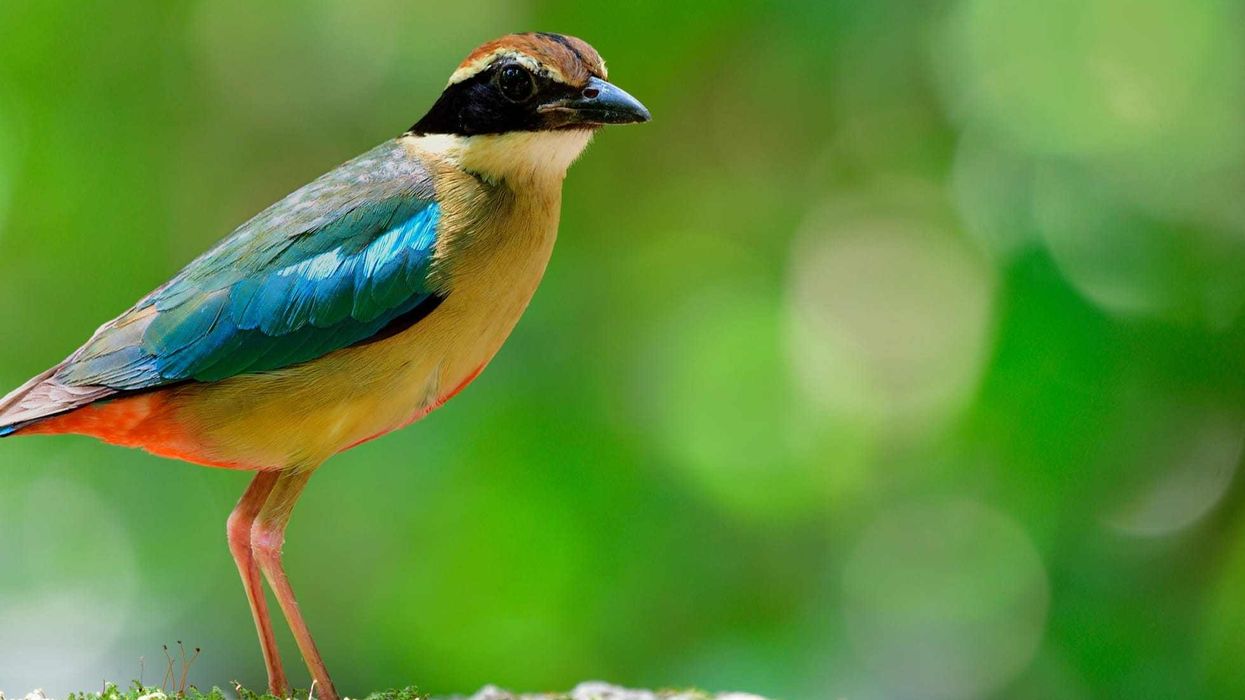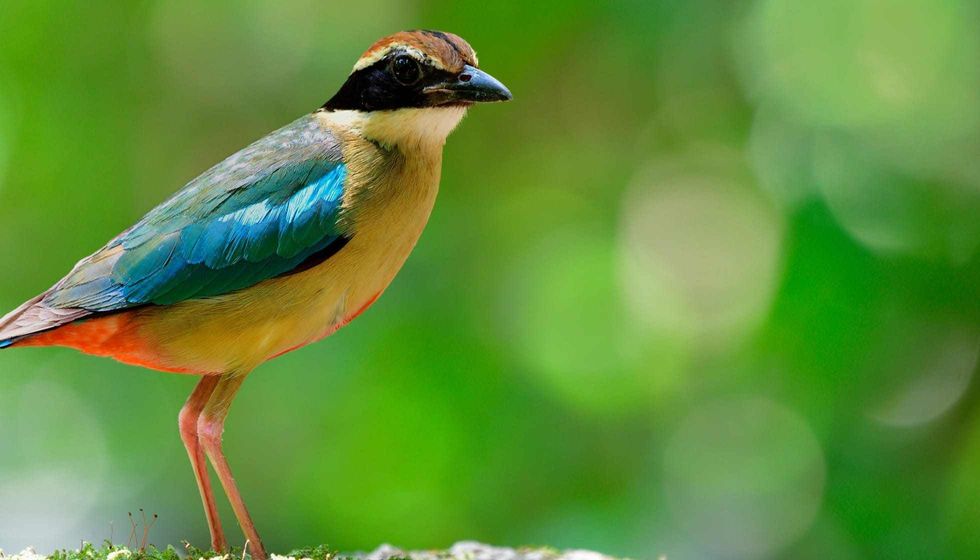Pitta is a family that includes 30 species of small and exceptionally brightly colored birds of the old world. The fairy pitta, with the scientific name Pitta nympha, of order Passeriformes and family Pittidae is one of the species of the old world passerine or perching birds that are found throughout Asia.
They have been sighted in India and the Indo-China Plain including Taiwan, the Borneo Islands, North and South Korea, and New Guinea. In East Asia, they are widespread throughout the Sea of Japan.
These birds from Borneo fly north to the islands of South Korea in search of forests especially camellia forest for breeding.
The breeding range also extends to east China and in some places in Taiwan. The Taiwanese population breeds in areas with a large variety of trees with a dense crown free of shrubs.
Fairy pitta birds breed in moderately elevated hilly or mountainous regions of Taiwan. In China as well as in Hong Kong, a similar trend of their migratory breeding range in mountain forests is observed.
To know more about the fairy pitta bird, keep on reading this article for more interesting facts. For similar content check out European robin and bee hummingbird facts too.
Fairy Pitta Interesting Facts
What type of animal is a fairy pitta?
A fairy pitta (Pitta nympha) is a type of bird.
What class of animal does a fairy pitta belong to?
Fairy pittas of the order Passeriformes and family Pittidae belong to the class Aves.
How many fairy pittas are there in the world?
The total fairy pitta population is not very accurately estimated. It is believed that there are a few tens of thousands of birds present in total.
The breeding pair population ranges between 100 to 10,000 while there are only about 50 to 1000 migrating individuals currently present all over Taiwan, China, Japan, North Korea, and South Korea.
The total population of this bird is thought to fall somewhere around 2500 to 9999 individual birds. However, this bird species is following a decreasing trend, steep enough to be classified as Vulnerable by the IUCN Red List.
Where does a fairy pitta live?
The fairy pitta is a migratory bird that shows extreme seasonal movements in winter and summer. These birds are found in northeast Asia from April to September. In the summer, they fly towards the south to southeast Asian countries.
What is a fairy pitta's habitat?
The habitat of fairy pitta birds varies according to the places in which they reside. They require particular habitat conditions and are locally distributed in subtropical forests.
This bird species breeds either along coasts, on islands, or in dense and moist deciduous forests in Korea. In Japan, they prefer living in places with dense bush, scrub, fern, and grass. They used to nest in evergreen broadleaf forests but currently nest in plantations as well.
Who do fairy pittas live with?
The fairy pitta is a very secretive species of bird creating their nests in a private place. While feeding, they wander in solitude.
How long does a fairy pitta live?
A healthy fairy pitta has a small generation length. They can stay alive up to four years of age.
How do they reproduce?
This species of fairy pitta nests in dark places like underground crevices or thick dense forests. Male birds defend their nests from intruders until the eggs are laid.
They border the nest with lichens and cattle dung. The bird breeds between May to July and lays up to four to six eggs per season. Both the males and females of this species incubate the eggs by taking turns and leave the nest during that span only on rare occasions.
The main duty of male birds is to protect the nests and their habitats while female birds feed the chicks. The young bird fledges a month or two after its birth.
What is their conservation status?
The beautiful species of the fairy pitta (Pitta nympha) has been classified as Vulnerable by the IUCN Red List. They are rapidly declining in numbers throughout their range. This bird species has been identified by various conservation sites in places like China, Taiwan, Japan, and Korea to protect their status.
Fairy Pitta Fun Facts
What do fairy pittas look like?
The fairy pitta (Pitta nympha) is famous for flaunting a plumage of seven different colors of the rainbow. The back and the wing bows are jade green in color. The green color continues from its shoulder to the upper tail.
The dark green tail has a cobalt-colored tip. The primary and secondary coverts or feathers of the wings show various shades of blue.
The bird has whitish or cream underparts and a vibrant red stripe on the belly. On the head, they have a chestnut crown bordered by white color which looks like the bird's eyebrow. The bill is black and the legs are yellow.
How cute are they?
These birds look very beautiful in the wild. Their vibrant colors amplify when they fly. However, petting them is not suitable as the cage bird trade harms them.
How do they communicate?
The fairy pitta is a famous songbird of Asia that mainly communicates by vocalizations. Their call sounds similar to another pitta bird called the blue-winged pitta.
How big is a fairy pitta?
The length of this species of fairy pitta ranges between 6.3-7.7 in (16-19.5 cm). Their size is almost similar to the size of house sparrows.
How fast can a fairy pitta fly?
Pittas are reluctant fliers. They fly at moderate speeds but their speed is not determined.
How much does a fairy pitta weigh?
The weight of a fairy pitta is around 3.2 oz (90 g).
What are the male and female names of the species?
The male species of this bird are referred to as cocks and females are known as hens.
What would you call a baby fairy pitta?
A baby bird is called a chick or hatchling.
What do they eat?
They are carnivorous and feed on earthworms, insects, small snakes, frogs, snails, spiders, and lizards.
Are they dangerous?
These birds are not dangerous. They have a peaceful nature and do not attack unless provoked.
Would they make a good pet?
No, they do not make good pets. They are exotic wild birds and the cage bird trade hurts this species.
Did you know...
The fairy pitta is a migrant bird from Thailand and Hong Kong.
How did the fairy pitta get its name?
The fairy pitta was at first considered to be the same species of bird as the Indian pitta. However, differences in plumages, calls, and morphology gave rise to another different species which was named the fairy pitta.
What are the threats facing the fairy pitta?
The main threat that the fairy pitta is facing is habitat destruction due to deforestation throughout their distributed land. Forest clearings in many places and the increase in human habitation have made them endangered and rare.
Here at Kidadl, we have carefully created lots of interesting family-friendly animal facts for everyone to discover! Learn more about some other birds including mockingbirds or rufous hummingbirds.
You can even occupy yourself at home by coloring in one of our free printable fairy pitta coloring pages.









